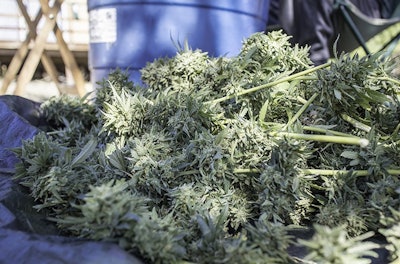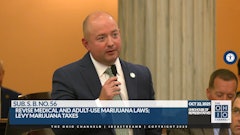
This fall, outdoor recreational cannabis growers in Oregon will be required to notify the Oregon Liquor Control Commission (OLCC) of their harvests in a statewide push to prevent diversion from the legal market.
According to OAR 845-025-2090, which went into effect Aug. 1, a licensed producer in the state’s recreational marijuana program “must file a harvest notice before harvesting usable marijuana from any mature plant located in an outdoor canopy area.” The notice must be filed through the Metrc, the state’s cannabis tracking system, by 9 a.m. on the day of harvest, identifying the dates of the proposed harvest. If the harvest does not ultimately take place on those dates, the notice must be withdrawn or amended within 24 hours. (Read the full notice below.)
In the proposed regulations, outdoor producers only had to notify the OLCC of five to seven select harvests as a sampling, but concerns raised during the public comment period on the proposed rules resulted in changes to the final law, Mark Pettinger, spokesperson for the OLCC’s recreational marijuana program, told Cannabis Business Times.
“Instead of having this be a random thing, we required it to be consistent, every time you harvest, so that takes a little bit of the guesswork out of it,” Pettinger said. “It was designed to be simplified and consistent at the same time.”
Cultivators also pointed out during the public comment period that it is not ideal to file a harvest notification the night before, as growers could change their mind the next morning and decide not to harvest that day after all.
“One of the things we heard from producers was that it was cumbersome to make a decision about their crop the night before when either climate or weather changes or other issues might affect their crop … by the morning, when they had a chance to take a look at their crop and may [want] to postpone for a day or two because maybe the trichomes hadn’t peaked and weren’t what they wanted them to be,” Pettinger said. “So, the whole idea in terms of the modification was to make it as easy as a matter of a course of business, like any kind of activity—making sure that the drip irrigation is working or that things are checked into Metrc, whatever the normal course of business operation was. We try to make it as simple as possible.”
In an emailed message to licensed producers, OLCC Executive Director Steve Marks said, “The objective of this rule isn’t for the OLCC to be underfoot and disruptive, but to serve as an additional step ensuring the integrity of Oregon’s regulatory system while withstanding scrutiny by Federal law enforcement authorities.”
The harvest notification rules are meant to prevent the possibility of diversion into the illegal market, Pettinger added.
“Part of this is optics and that we need to make the system that we regulate as well-regulated as possible so that it withstands the scrutiny of particularly federal authorities who are focused on this issue,” Pettinger said. “It’s our belief that if we focus as much as we can on tightening down and limiting the leaks from the legal market that we regulate, that will enable law enforcement to better concentrate and better focus on illegal activity or diversion coming either from the medical market or from outright illegal grows on private or federal property.”
Marks added in his message that the intent of the rule “is to ensure the transparency and security of the regulatory framework and thus the health and stability of the industry,” and said, “In turn this enables the OLCC and our industry partners to demonstrate to Federal authorities Oregon’s commitment to keep cannabis products from being diverted to the illegal market. This proposed rule follows many actions the OLCC has worked with industry to put in to strengthen our regulated market.”
The regulations currently only apply to outdoor cultivation, as that is where a significant amount of the state’s cannabis comes from, Pettinger said.
“Historically—and this is noted through drug and addiction interception data—much of the cannabis that is diverted and transported illegally across state lines originates or is sourced from Southern Oregon, and specifically Josephine and Jackson Counties, which is the stronghold of outdoor cannabis production in Oregon,” Pettinger said. “That’s what that area is best-known for in terms of the cannabis industry. That’s where the best sun-grown cannabis comes from. So, in particular, because of that and because the significant number of our [licensed producers] … come from Josephine or Jackson County, that’s a primary thrust of the rule and why it’s applying now toward the outdoor harvest because that is already taking place and will continue through the fall.
“It doesn’t mean that we won’t consider doing the same thing for the indoor grow,” Pettinger added, “but we need to start somewhere and the outdoor harvest is an annual event, whereas if you’re an indoor producer, you’re producing crop year-round and not every producer’s on the same schedule, so it’s going to be staggered, whereas the window of the harvest in the outdoor season is going to be pretty fixed.”
Outdoor cannabis harvest notification rules: Oregon Liquor Control Commission by sandydocs on Scribd
Top Image: © Jenny | Adobe Stock

























